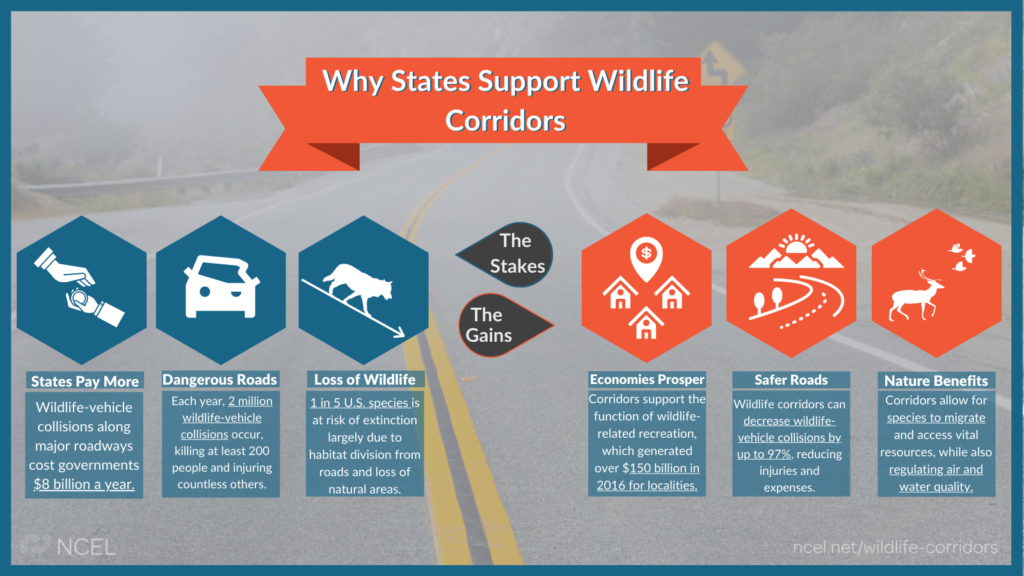
NCEL Blog
Human-Wildlife Coexistence: A Sustainable Framework for our Changing World
May 3, 2021 | This is a guest blog written by Justin Gulino, NCEL’s Conservation Intern. He is a current undergraduate student at the George Washington University and is seeking a dual degree in Environmental Science and International Affairs.
The Need for Coexistence with Nature
The importance of human-wildlife coexistence is increasing as our population grows and we encroach further upon shrinking natural habitats and ecosystems. Unfortunately, this increased proximity frequently pits wildlife against humans. This may be in the form of carnivores threatening livestock, bears foraying into backyards, or deer colliding with cars. Billions of dollars in damages occur from conflict each year across the United States, spanning the rural plains to our most urban cities. There are non-lethal, cost-effective solutions to mitigate these incidences and change this narrative with wildlife from one of conflict to coexistence.
Deer: Danger on Our Roads
The most prevalent, costly, and deadly incidence of human-wildlife conflict occurs on the roads. From interstates to side streets, automobile collisions with wildlife cause over $8 billion in damages and claim 200 human lives per year. Deer are the most common animal involved in collisions with bigger species such as elk and moose causing the most severe damage.

Traditional passive methods such as deer warning signs and reflective light only slightly decrease collisions. Newer methods that put the emphasis on changing wildlife instead of human behavior appear to be vastly more successful. Wildlife corridors and crossings are one approach that attempts to shift wildlife crossings off highways through the use of bridges and tunnels. Corridors successfully reduce collisions by as much as 97% when implemented with ancillary roadside-fencing measures. The establishment of additional corridors can be a powerful tool to keep both humans and wildlife safe while preventing billions of dollars in damages.
Unwelcome Backyard Guests
Incidents of conflict may also manifest themselves in the very places we reside, especially as suburbs expand into traditionally forested areas. A bear on a person’s backyard trampoline may seem like a funny video clip to some, but it can be a very real and serious reality for many people. Black bears are found throughout the United States, occupying areas from the Atlantic to the Pacific and from Florida to Alaska. Unfortunately, this often puts bears and humans in close proximity to each other.
Bears are most attracted to residential areas due to food sources such as unsecured garbage, fruit trees, and bird feeders. Bears that find food near people can become increasingly bold, and so they are often killed by wildlife managers. Colorado passed HB 15-1304, ordering a report to find solutions to mitigate this issue. Some solutions proposed were:
- Improve community waste disposal from curbside to landfill.
- Increase enforcement and education of feeding prohibition.
- Use of rubber bullets or hounds for troublesome habituated bears.
These strategies can allow bears to coexist alongside humans by keeping bears in their habitats and out of our backyards.
Wolves: Not So Big and Bad
Perhaps the most envisioned culprit of human-wildlife conflict is the wolf. However, their historical portrayal as the enemy of townspeople and farmers is severely undeserved. This perception significantly impacted policy initiatives towards them, to the point when they were effectively eradicated from the lower 48 states. Reintroductions have allowed wolves to be delisted from the Endangered Species Act, leaving states and tribes responsible for wolf population management.
Increased wolf numbers cause more interactions with humans. This tends to lead to presumptions that they are a major threat to livestock herds often spurring preemptive and misguided wolf killings. The preemptive killing of wolves often results in the breakdown of pack hierarchy. This leaves younger wolves that may take livestock at higher rates due to their diminished hunting ability. Research now finds that non-lethal mitigation strategies are more successful and cost-effective at reducing livestock losses than wolf killings. The Wood River Wolf project reflects this successfully, having reduced livestock losses to less than 1% of total herd size with minimal wolf killings through the use of non-lethal coexistence strategies such as:
- Increased human presence alongside livestock herds (WA SB 5092).
- Use of non-lethal tools such as lights, sound devices, and flagging on fence lines (MN HF 1545-1).
- Incorporation of livestock guardian dogs into herds.
These techniques can serve as a model and be replicated elsewhere to promote better wolf-human relations throughout the United States.
State Options to Change the Narrative
The above three cases are only a small subset of the types of human-wildlife conflict present in the United States. Yet, these cases are the most representative and common forms of conflict. Wolves and bears are not the sole threat to livestock – cougars and coyotes also present issues. Meanwhile, squirrels, mice, and raccoons cause even more property damage than bears. Finally, collisions affect all wildlife from small birds to mighty bison.
States can take the lead on these issues by passing legislation to promote coexistence. Connecticut’s SB 137 aims to promote non-lethal methods and the prohibition of feedings to reduce suburban bear interactions and may serve as a template if passed. Nonlethal management of carnivores such as Washington’s HB 2126 sets a precedent for coexistence rather than conflict. The establishment of wildlife corridors by states such as Virginia’s SB 1274 will create safe motorways for both wildlife and humans. The adoption of successful coexistence strategies such as those described above could encourage a paradigm shift of more harmony with the natural world as we navigate a new era of interconnectedness with nature.